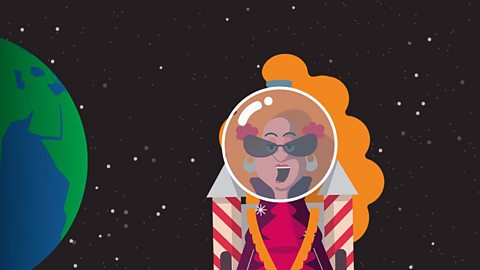Key information
Our Solar System is amazing!
At the centre is the Sun. Orbiting around the Sun are eight planets with over 100 moons between them, at least five dwarf planets, countless asteroids and the occasional comet.
In this Space guide you can learn about:
- the role of the Sun in the Solar System
- the different types of planets: terrestrial, gas and ice
- the main features of the other planets
- how we explore space and learn about other stars and planets
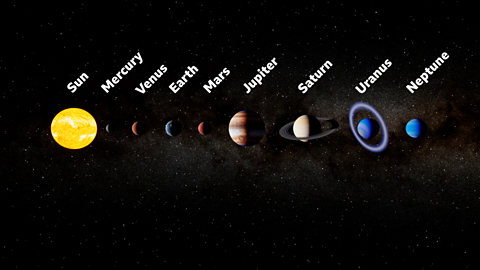
Watch
Watch this video to find out more about the Earth, planets in our Solar System and other planets far off in outer space.
From up here on the International Space Station I get a great view of Earth.
Our planet is just the right distance from the Sun for life to exist.
We call it a Goldilocks planet because the EarthвҖҷs temperature, like the porridge in the Goldilocks fairy tale, is not too hot and not too cold.
This is because the Earth has an atmosphere which holds onto the SunвҖҷs warmth whilst also protecting us from the SunвҖҷs rays.
But whatвҖҷs it like on other planets?
There are eight planets in our solar system. The closest one to the sun is Mercury, then itвҖҷs Venus, Earth, Mars, Jupiter, Saturn, Uranus, and Neptune.
The eight planets travel around the Sun at different speeds. These lines show us the paths they take which we call orbits.
On a clear night from Earth we can sometimes see the five planets which are closest to us - Mercury, Venus, Mars, Jupiter and Saturn.
Using a powerful telescope can also see Uranus and Neptune but to get an even clearer view we send telescopes into space, like this one - the Hubble space telescope.
We have also sent probes into space.
Probes are space crafts with cameras to send images back to Earth. This allows us to compare the planets in even more detail.
Mercury and Venus are both rocky planets. Mercury is closest to the Sun, so it gets very hot during the day. But it has a very thin atmosphere which does not hold on to any heat, so it gets very cold at night in the shade.
Venus, on the other hand, has a thick atmosphere which holds onto heat from the Sun. So, even though Mercury is closer to the Sun, Venus is the hottest planet in the solar system.
Mars has a hard, rocky surface with lots of iron in the soil which rusts, making the surface and atmosphere look red. This is why we call Mars, the Red Planet.
Mars is most like Earth.
Both have valleys and mountains, weather and seasons, ice caps and volcanoes.
Robotic vehicles called rovers have been sent to Mars to collect information. The Perseverance rover is up there now, studying the Martian climate and weather.
It tests technologies that could help humans survive on Mars.
The two largest planets are Jupiter and Saturn.
They are called Gas Giants as they don't have hard surfaces, but instead have swirling gases above a solid core.
On the surface of Jupiter there is a huge red spot twice as wide as planet Earth.
When the Voyager 1 probe flew past Jupiter, the images it sent back showed that this Great Red Spot is a huge storm which has been raging for over three hundred years.
Saturn is best known for its rings, which are made of chunks of ice and rock.
Uranus and Neptune are the furthest planets from the Sun. They are known as the Ice Giants.
Uranus is the coldest planet in the Solar System. Unlike the other planets, Uranus spins on its side.
Neptune is the furthest planet from the Sun, thirty times further than Earth. Its orbit is so huge that one year on Neptune takes almost 'one hundred and sixty five' Earth years.
The James Webb space telescope is currently one million miles from Earth. It is being used to explore the beginning of the Universe, study how stars are born, and look for Goldilocks planets in other solar systems.
The Sun
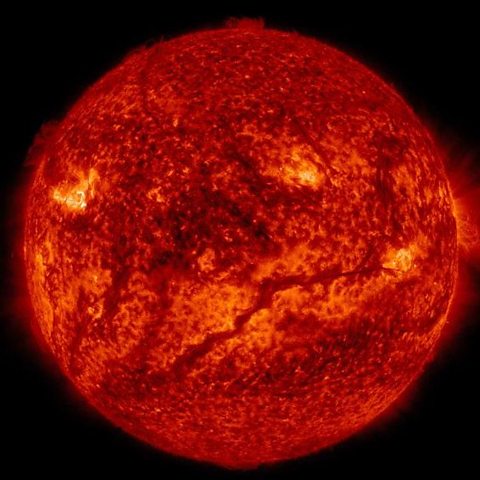 Image source, NASA
Image source, NASAIn the centre of the Solar System is the Sun, our star. It is a huge ball of burning gas made mostly of hydrogen.
The Sun makes up 99% of all the mass in the Solar System; that means if you put together everything else in the Solar System, the Sun would be 99 times more massive!
Astronomers think the Sun is about 4.6 billion years old and it is about half way through its life.
 Image source, NASA
Image source, NASAThe planets
Every object in our Solar System is held in place by the SunвҖҷs gravitational pull.
The planets in the Solar System are all different but we can divide them into groups based on their common features.
There are four Sorry, something went wrongCheck your connection, refresh the page and try again. planets (Mercury, Venus, Earth and Mars) which have solid, rocky surfaces.
There are two gas giants (Jupiter and Saturn) which are made of gas and are the largest planets in the Solar System.
There are two ice giants (Uranus and Neptune) which are so far from the Sun that they are frozen solid.
Mercury
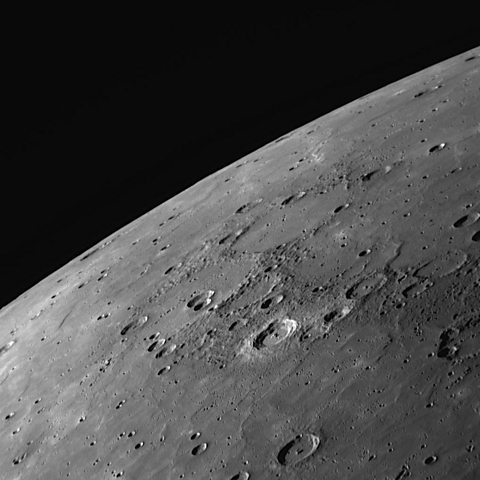 Image source, NASA
Image source, NASASorry, something went wrongCheck your connection, refresh the page and try again. is a small rocky sphere, not much bigger than our Moon.
It is the closest planet to the Sun, about two fifths of the distance between the Sun and Earth. This means the side facing the Sun can get very hot - up to 430В°°д during the day.
But Mercury has almost no atmosphere, so it does not hold onto this heat. The side facing away from the Sun cools down to -180В°°д at night.
It takes Mercury 59 days to spin round once on its axis. Mercury travels very fast around a short orbit, so its year is only 88 days long.
 Image source, NASA
Image source, NASAVenus
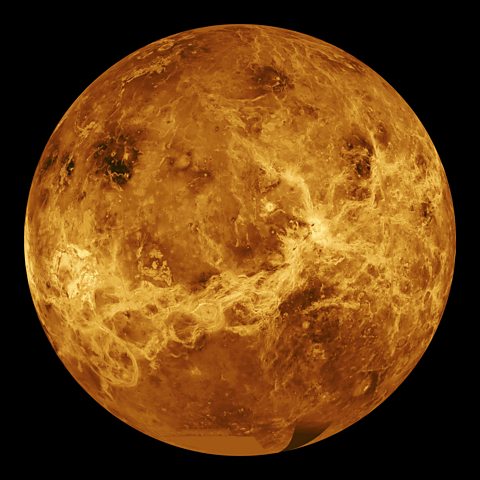 Image source, NASA
Image source, NASASorry, something went wrongCheck your connection, refresh the page and try again. is the second planet from the Sun - about three quarters of the distance between the Sun and Earth. It is known as EarthвҖҷs twin because they have very similar sizes.
Venus is the hottest planet in the Solar System with an average temperature of 460В°°д.
Its thick atmosphere acts like a blanket trapping the SunвҖҷs heat inside.
The surface of Venus is dry and rocky with lava flows across parts of the planet.
It takes Venus 243 Earth days to spin round on its axis but only 225 days to complete an orbit of the Sun. So a day on Venus is actually longer than a year!
 Image source, NASA
Image source, NASAEarth
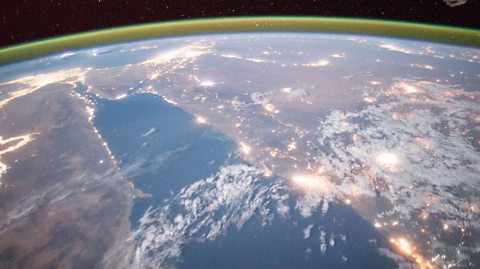 Image source, NASA
Image source, NASASorry, something went wrongCheck your connection, refresh the page and try again. is the third planet from the Sun and the only planet in the Solar System with life on it.
Our planet is habitable because it is just the right temperature to support life.
Earth lies in the Goldilocks Zone where it is not so close to the Sun that it gets too hot and not so far from the Sun that it gets too cold.
It also has an ideal atmosphere, which traps just the right amount of the SunвҖҷs heat to keep Earth's temperature stable.
Both these features contribute to Earth having liquid water on the surface, which living things need to survive.
 Image source, NASA
Image source, NASAMars
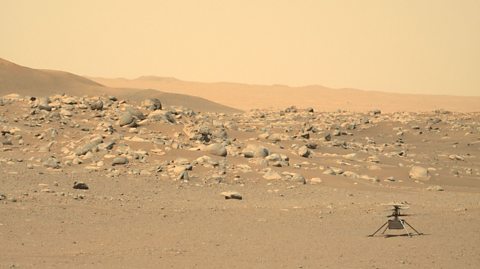
Sorry, something went wrongCheck your connection, refresh the page and try again. is the fourth planet from the Sun and the last of the terrestrial planets. It is about half the size of Earth and about one and a half times the distance from the Sun that Earth is.
Like Earth, Mars is in the Goldilocks zone but its thin atmosphere does not trap enough of the Sun's heat to have a stable temperature. At its hottest, Mars reaches about 20 В°C but this can drop to -153 В°C. There is water on Mars but it is in the form of ice under the surface at the planet's poles.
Evidence from the Curiosity and Perseverence rovers on the surface of Mars shows that Mars used to have a thicker atmosphere and it once had liquid water on the surface, and therefore possibly life.
Mars has two moons. A day on Mars lasts just over 24 hours and a year lasts 687 Earth days.

Why does Mars look red?
Mars looks red because its surface contains a lot of iron.
This iron has rusted through oxidation (a chemical reaction when iron meets oxygen and water) which gives the ground a red-brown colour.
Strong winds have broken up the surface spreading red rusty dust all through Mars's atmosphere so even the sky looks red!
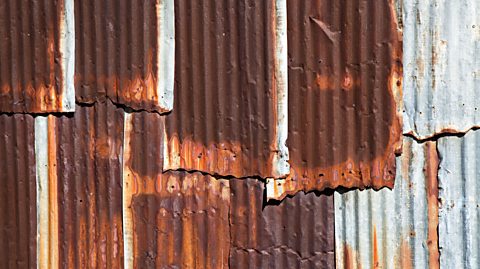
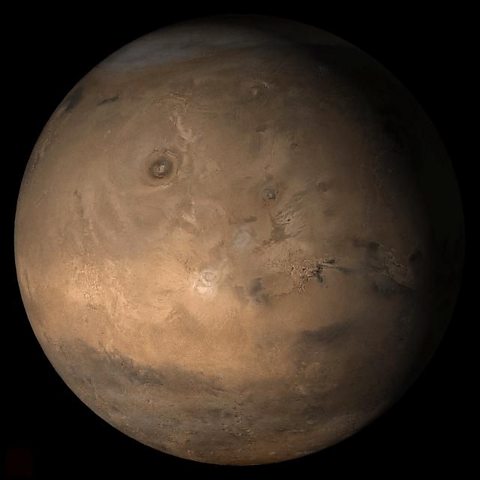
Asteroid belt
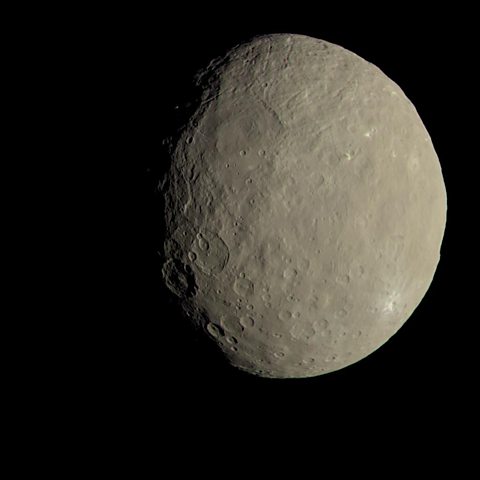
Between Mars and Jupiter is the main Sorry, something went wrongCheck your connection, refresh the page and try again..
Asteroids are rocky objects that orbit the Sun, just like planets do. There are millions of asteroids of very different shapes and sizes.
- Some are almost spheres, like planets, but most are irregular shapes.
- Some are the size of small stones and pebbles.
- Some measure hundreds of kilometres across.
The largest object is the asteroid belt is the dwarf planet Ceres, which is 950km in diameter (that's about the same the length as Great Britain).

Jupiter
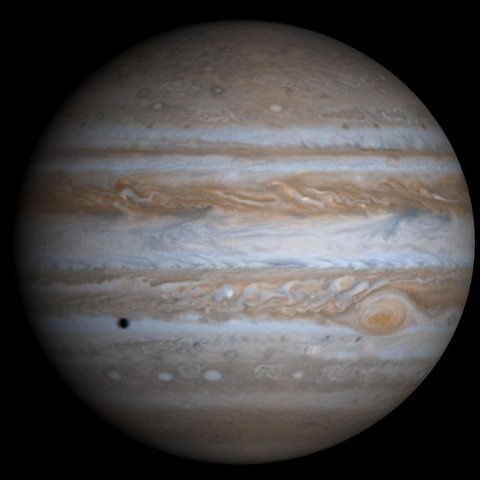 Image source, NASA
Image source, NASASorry, something went wrongCheck your connection, refresh the page and try again. is the fifth planet from the Sun and the largest planet in the Solar System.
It is about five times the distance from the Sun that Earth is and eleven times the width of Earth. Jupiter is so huge that it is twice as massive as all the other planets in the Solar System put together.
Jupiter's stripy appearance is caused by winds blowing clouds of different types of ice, liquid and gas around. The Great Red Spot on its surface is a huge storm that has been raging for at least 300 years.
Jupiter is thought to have 80 moons. The largest four are called Io, Europa, Ganymede and Callisto, They can be seen from Earth with a pair of binoculars or a telescope.
A day on Jupiter lasts less than ten hours and a year takes around twelve Earth years.
 Image source, NASA
Image source, NASASaturn
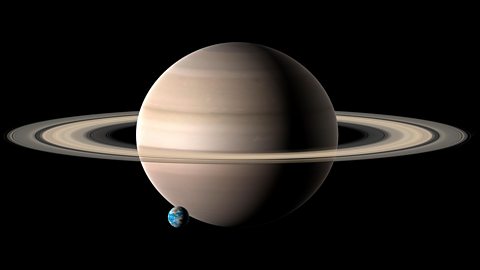
Sorry, something went wrongCheck your connection, refresh the page and try again. is the sixth planet from the Sun and the second gas giant.
It is about nine times the width of Earth and nine and a half time further away from the Sun.
Saturn is the least dense planet. Its density is so low that it would float on water вҖ“ if you could find a bathtub big enough!
Saturn is famous for its beautiful rings which extend out about 280,000 km from the planet, the rings have an average thickness of only 10m.
The rings are thought to be bits of comets, asteroids, or moons that broke up before they reached the planet. As well as its rings, Saturn is orbited by 83 moons.
A day on Saturn lasts for just under eleven hours, while a year is about 29 Earth years.

Uranus
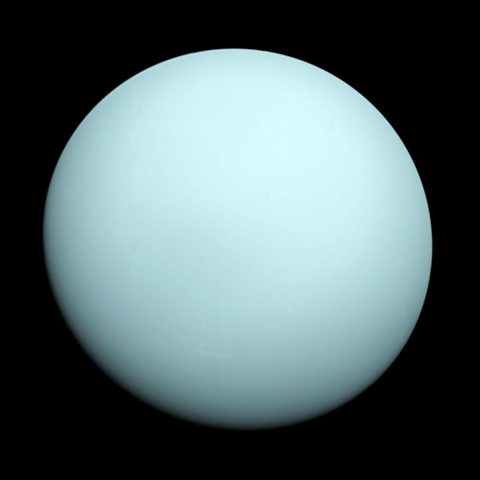 Image source, NASA
Image source, NASASorry, something went wrongCheck your connection, refresh the page and try again. is the seventh planet from the Sun and the first of the ice giants.
It is four times wider than Earth and nearly twenty times further from the Sun.
Because it is so far from the Sun, the average temperature on the surface is only - 195В°C. The coldest recorded temperature on Uranus was - 224В°C, which is the coldest temperature recorded on any of the planets.
Uranus has at least 27 moons, 13 rings and spins on its side like a ball rolling along its orbit. It is the only planet to do this.
A day on Uranus takes 17 hours, while a year is 84 times an Earth year.
 Image source, NASA
Image source, NASANeptune
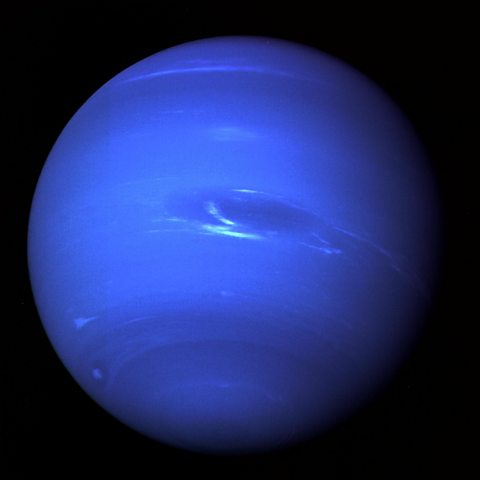 Image source, NASA
Image source, NASASorry, something went wrongCheck your connection, refresh the page and try again. is the eighth planet from the Sun and the second of the ice giants. It is the only planet in the Solar System that we cannot see with just our eyes.
It is about four times wider than Earth and thirty times further from the Sun.
At 4.5 billion km from the Sun, it receives very little heat and so has an average temperature of just -200В°°д.
Neptune has 13 moons. A day on Neptune lasts around 16 hours and it takes about 165 Earth years to orbit the Sun once.
 Image source, NASA
Image source, NASAEdge of the Solar System
Beyond Neptune is the Sorry, something went wrongCheck your connection, refresh the page and try again..
Instead of rocky asteroids it contains objects made from ice, rock and dust, including the dwarf planet Sorry, something went wrongCheck your connection, refresh the page and try again..
In terms of planets, dwarf planets and asteroids, this is the edge of the Solar System.
The gravitational force of the Sun reaches way beyond Pluto and the Kuiper Belt, to what is called the Sorry, something went wrongCheck your connection, refresh the page and try again..
While planets and asteroids fly around the Sun in flat circular or oval orbits, the Oort Cloud is more like a sphere, with many icy objects spread out all around it.
No-one knows for sure, but it is thought that the closest part of the Oort Cloud might be 2, 000 times further from the Sun than Earth. Its furthest parts could be as far as 100, 000 times further away.
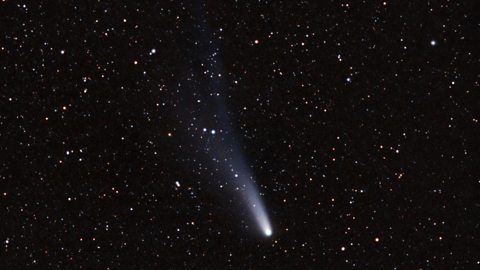
Comets
Sorry, something went wrongCheck your connection, refresh the page and try again. are frozen objects made from ice, dust and rocks. They sometimes come much closer to the Sun, which makes them warm up.
As they heat up, some of the ice melts. This releases glowing gases and dust which form a tail that stretches out behind the comet.
Some comets have regular orbits so astronomers can predict when they will be visible from Earth. Halley's comet was discovered in 1682 and returns every 76 years. It will appear next in the year 2062.

Our galaxy
Our Sun seems much bigger than other stars in the sky because it is much closer to Earth. But compared to other stars it is only of average size.
Our Sun is just one of many billions of stars in our galaxy, which is called the Milky Way. The Milky Way is a spiral galaxy and our Solar System is about half-way along one of its arms.
Our Sun orbits the centre of the Milky Way at about 140 miles every second. It takes about 230 million years for for it, and us, to complete one full orbit.
And the Milk Way is just one galaxy in the Universe.
The Hubble Space Telescope has discovered around 100 billion galaxies and the James Webb Telescope will be able to find even more. Astronomers think that there are 200 billion or more galaxies.
The Universe is huge!
Quiz
Test how much you know about the planets of our Solar System with this quiz!

Solar System вҖ“ A group of objects orbiting around a star.
Planet вҖ“ A large, spherical object orbiting a star.
Moon вҖ“ A large object orbiting a planet.
Orbit вҖ“ the path an object takes round another object.
Day вҖ“ the length of time a planet takes to complete one spin.
Year вҖ“ the length of time a planet takes to complete one orbit of the Sun.
Mass вҖ“ the вҖҳstuffвҖҷ that something is made of, all the matter that makes up that object.
Goldilocks Zone вҖ“ the distance from a star where the temperature is not too cold, not too hot, but just right for the conditions for life to exist.
More on Earth and space
Find out more by working through a topic
- count2 of 18
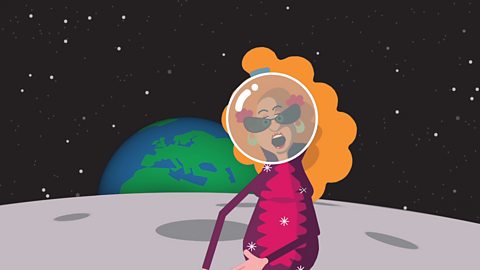
- count3 of 18

- count4 of 18
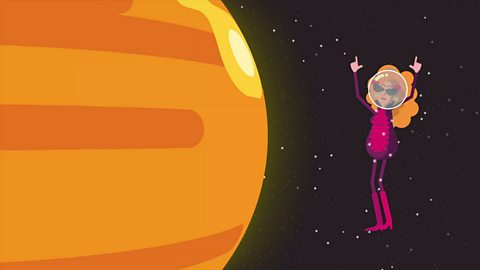
- count5 of 18
